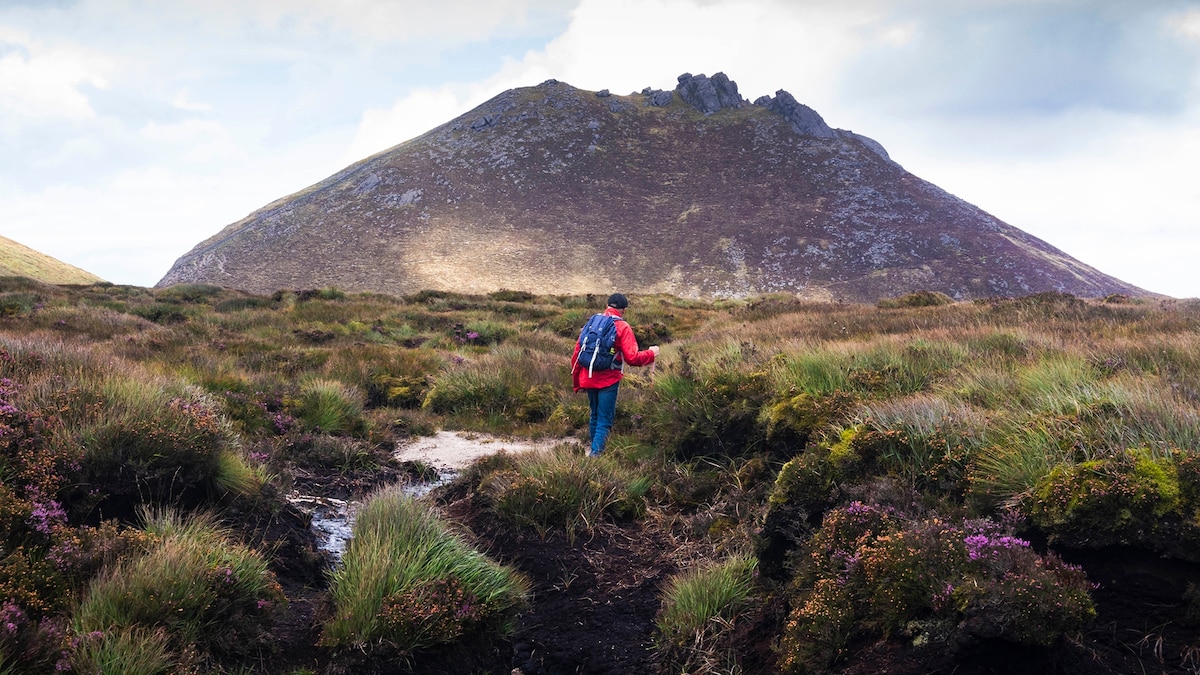Now Reading: 7 of the best pilgrimages in the UK
-
01
7 of the best pilgrimages in the UK
7 of the best pilgrimages in the UK

This article was produced by National Geographic Traveller (UK).
Back in the day, a pilgrimage meant a journey to a sacred place as an act of religious devotion. Today, for increasing numbers of pilgrims, it’s a journey made with purpose and a touch of spirituality — though not necessarily driven by faith. The UK has become one of the world’s most secular countries; the last census saw the percentage of Christians in England and Wales drop from 59% to 46%. And yet the country is leading the way in revitalising pilgrim trails — from church-hopping around rural Herefordshire to routes spanning the Irish Sea.
Simply put, making a pilgrimage hasn’t been this popular since the Middle Ages. But why? As the world becomes ever more complicated, taking time out for a long walk — when all you have to think about is food, shelter and putting one foot ahead of the other — is increasingly appealing. A pilgrimage is wellness at its simplest, and an antidote to fast-paced 21st-century life.
1. Golden Valley Pilgrim Way, southwest Herefordshire
The Golden Valley Pilgrim Way doesn’t get you anywhere. Unusually for a pilgrimage, this 60-mile route is not linear but a loop, winding through rolling, rural, time-warp southwest Herefordshire to finish back where it started, at the door of Hereford’s 11th-century cathedral. But it’s a journey that provokes spiritual contemplation. Night sanctuary is offered at nine churches en route (suggested donation: £20 per person per night), offering camp beds, access to a toilet and sink, and the privilege of bunking down in sacred, historic, community-rooted spaces. These include Madley Church, which has been attracting pilgrims since the sixth century (St Dubricius was reputedly born here), and St Clydawg’s in Clodock, rich in intriguing ecclesiastical details and located near to the characterful Cornewall Arms pub. There’s also the chance to sleep in the cloisters of Hereford Cathedral, thought to be the first British cathedral to allow pilgrims to stay since medieval times.


Eildon Hills provide impressive viewpoints for pilgrims en route to Northumberland’s Holy Island.
Photograph by Gabriel Hemery, Getty Images
2. St Cuthbert’s Way, Scottish Borders and Northumberland
Tracing the footsteps of its namesake seventh-century saint, the 62-mile St Cuthbert’s Way runs from the Scottish Borders town of Melrose, where St Cuthbert entered monastic life, to Holy Island, his eventual resting place and original shrine. It’s perhaps the godfather of modern British pilgrimages: the trail opened in 1996 and has become beloved of both pilgrims and seasoned ramblers who rate its manageable distance, wild and varied terrain, lower-key status and historic significance.
En route lie the distinctive Eildon Hills, the burbling River Tweed, ruined abbeys, the remote Cheviots and St Cuthbert’s Cave where, it’s said, the saint’s body was hidden in 875 during Viking raids. The trail delivers one of the finest finales, too: the walk to Holy Island, either across the causeway or over the tidal mudflats — many make the journey barefoot — to reach the ruins of Lindisfarne Priory, where St Cuthbert was made bishop in 685.
3. St Patrick’s Way, County Armagh and County Down
Remarkably, a pilgrimage celebrating Ireland’s patron saint only launched in 2015. It was the brainchild of an Irishman — artist and pilgrim Alan Graham — who’d walked Spain’s Camino de Santiago and thought there should be something similar back home. The 82-mile route links the ceremonial site of Navan Fort, on the outskirts of Armagh, and the town of Downpatrick — two places with the strongest links to the man who brought Christianity to Ireland. Patrick chose Armagh to be the seat of the new religion, founding his main church there in 445 CE. Downpatrick is where he allegedly built his first church, and where he’s believed to be buried.
Along the way, the well-signed trail traverses green and glorious countryside, follows canals, enters the mighty Mourne Mountains, veers into seaside Newcastle, runs through Murlough Bay Nature Reserve and passes ruined Dundrum Castle. Walkers can carry a pilgrim’s passport, collecting stamps along the way to earn a certificate from Downpatrick’s Saint Patrick Centre.
4. Cornish Celtic Way, Cornwall
It was around the sixth century when saints first went to spread Christianity across England’s southwesterly extreme. And the Cornish Celtic Way is a modern take on their ancient journeys. The 125-mile route, linking St Germans and St Michael’s Mount, passes evidence of those early Christians, from Celtic crosses to holy wells. It also traverses the wild moorlands, woodlands and cliff-backed shores that made them feel so close to God.
The trail combines 60 miles of Cornish coast path with two existing pilgrim trails. The Saints Way, from Padstow to Fowey, follows the likely route pilgrims once used to travel from Ireland and Wales to France and passes ancient footbridges and medieval churches. St Michael’s Way is a shortcut across the county from Lelant to the castle-crowned tidal isle of St Michael’s Mount. A trail passport enables walkers to collect stamps en route and book discounted accommodation, including stays in churches and church halls.

Pilgrims can best view the Pembrokeshire coastline from the highest point on St Davids head of Carn Llidi.
Photograph by Tony Eves, Alamy
5. Wexford-Pembrokeshire Trail, Ireland & Wales
The tagline of this trail, ‘two Celtic lands, two Celtic saints, one transformative journey,’ perfectly encapsulates its 162-mile route, which spans both land and sea, retracing the sixth-century journey of St Aidan to meet St David — an encounter that saw Celtic culture bloom. The journey begins with a 62-mile walk through County Wexford, from the holy well in Ferns to the port of Rosslare, followed by a 62-mile crossing of the Irish Sea and a 37-mile stretch along the Welsh coast, from Goodwick Harbour to the picturesque city of St Davids. The trail is divided into nine stages (five in Ireland, four in Wales), with guided events available. The Welsh section follows the signposted Pembrokeshire Coast Path, complemented by a digital map for navigation.
This adventure is imbued with ancient echoes, passing many pilgrim sites. These include St David’s Well near Oilgate; Our Lady’s Island, a place of female worship; a hermit’s cell at the foot of Garn Fawr; the Neolithic burial stone of Carreg Samson; and the summit of Carn Llidi, where angels allegedly told St Patrick to return to Ireland.
6. The Old Way, Southern England
The Old Way, a 240-mile pilgrimage from Southampton to Canterbury, blends history from both 2020 and the 14th century. Inspired by a red line on the Gough Map (circa 1360), the oldest known road map of Britain, the route was revived by the British Pilgrimage Trust, a charity dedicated to promoting and modernising the cultural and spiritual significance of this ancient form of travel.
The route takes between two and four weeks to complete, following a slightly altered path from the original red line to avoid modern highways and connect key pilgrimage sites. These include the ruins of Titchfield Abbey, magnificent Chichester Cathedral, the ancient trackways of the South Downs and a series of medieval churches and mystical natural locations, from quiet forests to eerie marshlands. Along the way, low-cost accommodation is available at various sanctuaries, from churches and community centres to camping fields. These options offer reasonable prices for pilgrims while providing revenue for local communities.

The Way of Life passes by Durham Cathedral, a few miles south of Newcastle-upon-Tyne.
Photograph by David Tomlinson, Getty Images
7. Northern Saints Trails, County Durham
Launched in 2021, the six Northern Saints Trails follow the paths of those who made northeast England the heart of Christianity in medieval Britain. For example, the 29-mile Way of Life, from Gainford to Durham, is steeped in the stories of St Cuthbert, the former bishop of Lindisfarne, whose remains were brought to Durham Cathedral in the ninth century. This route passes St Oswald’s Church, where Cuthbert is said to have performed a miracle, as well as Escomb, the oldest complete Saxon church in England.
The Way of Learning, a 38-mile route from Jarrow to Durham, follows the path of the Venerable Bede, one of the greatest Anglo-Saxon scholars, whose shrine has been in Durham Cathedral since the 14th century.
Meanwhile, the Way of Love, a 28-mile route from Durham to Hartlepool, highlights three of English Christianity’s most significant female figures: St Hilda, St Helena and St Mary Magdalene. In addition to these trails, the 22-mile Finchale Camino Inglés, from Finchale Priory to Gainford, is recognised as the English section of the Camino de Santiago. It was from Finchale that St Godric set out in the 12th century as the first recorded British pilgrim to Santiago de Compostela.
To subscribe to National Geographic Traveller (UK) magazine click here. (Available in select countries only).























